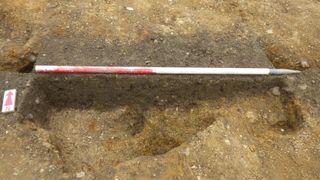Amphibian 'death pit' filled with 8,000 bones unearthed in Iron Age village
How did the shattered corpses end up there?

A death pit of 8,000 frog and toad bones dating back at least 2,000 years has archaeologists in England stumped as to how the shattered amphibian corpses got there, with ideas ranging from death by cold to a nasty nosedive to a disease killer.
This is a puzzling and unexpected find, which we are still trying to fully understand," Vicki Ewens, senior archaeozoologist at the Museum of London Archaeology, said in a statement. "This accumulation of frog remains may have been caused by a number of different factors, possibly interacting over a long period of time."
The team found the bones at an ancient settlement in Bar Hill, in Cambridgeshire, England, that was in use between roughly 400 B.C. and A.D. 70. The bones are from at least 350 individual frogs and toads, and the ditch where they were found is located next to a roundhouse— a home with a circular layout, archaeologists said in the statement. There is no evidence that the frogs and toads were eaten by humans or other animals.
Related: Top 10 most fascinating archaeological discoveries of 2021

The researchers have several ideas to explain how the skeletal remains got into the ditch. One possibility is that during their breeding season in the springtime, a large number of frogs and toads were moving en masse in search of waters to mate in, only to fall into a ditch that they couldn't escape, the archaeologists said in the statement.
Another possibility is that an infectious virus infected and killed these amphibians around the same time. A similar scenario played out in the 1980s when many frogs in the U.K. became infected with a Ranavirus, archaeologists noted in the statement.
The amphibians could have also died during a particularly cold winter. Yet another possibility is that beetles and aphids (group of sap-sucking insects) swarmed to grain from the roundhouse and their presence attracted frogs and toads that ate them; over a period of time and the frogs could have died in the ditch because they couldn't climb out.
Sign up for the Live Science daily newsletter now
Get the world’s most fascinating discoveries delivered straight to your inbox.
Scholars react

A number of scholars not affiliated with the research were excited by the discovery.
"This is a fascinating find. There is no way to know whether a pathogen/disease was responsible, but the suggestion [that] the frogs could have fallen into the ditch of the roundhouse during migration and were unable to climb out seems reasonable as a 'best guess,'" Roland Knapp, a research biologist at the University of California Santa Barbara’s Marine Science Institute, told Live Science in an email. Knapp has researched and written extensively on amphibians.
"I think this news is exciting and intriguing," Jamie Voyles, an associate professor of biology at University of Nevada Reno, told Live Science in an email. "Even in contemporary times, it can be really difficult to determine the cause(s) of mass mortality events. That said, yes, I would say that infectious disease is one possibility that could be considered and investigated.".
Archaeologists excavated at Bar Hill ahead of a construction project to expand a highway in the area. Excavations are complete, and analysis of the artifacts is ongoing. A spokesperson for Museum of London Archaeology said that there are no plans to conduct DNA analysis of the frog and toad bones. Ewens was not able to reply to Live Science at the time of publication.
Originally published on Live Science.

Owen Jarus is a regular contributor to Live Science who writes about archaeology and humans' past. He has also written for The Independent (UK), The Canadian Press (CP) and The Associated Press (AP), among others. Owen has a bachelor of arts degree from the University of Toronto and a journalism degree from Ryerson University.